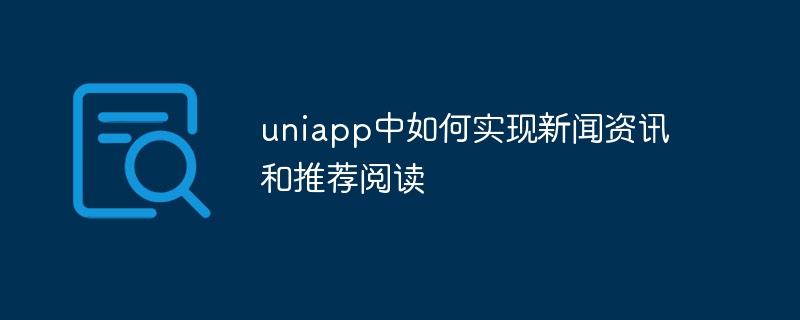

How to implement news information and recommended reading in uniapp
With the rapid development of the mobile Internet, people's demand for news and information is getting higher and higher. In uniapp, it is a common requirement to implement news information and recommended reading functions. This article will introduce how to implement these two functions in uniapp and provide specific code examples.
1. Implementation of the news information function
Before implementing the news information function, you first need to prepare the news data source. You can obtain news data through the backend server interface, or simulate data for testing.
In uniapp, news information is generally displayed in the form of a list. Lists can be built using <ul></ul> and <li>.
Sample code:
<template>
<view class="news-list">
<ul>
<li v-for="(item, index) in newsList" :key="index" @click="goToDetail(item.id)">
<view class="news-item">
<image :src="item.image"></image>
<view class="news-info">
<text class="news-title">{{ item.title }}</text>
<text class="news-time">{{ item.time }}</text>
</view>
</view>
</li>
</ul>
</view>
</template>Use the data binding function of uniapp to render the prepared news data into the page.
Sample code:
<template>
...
</template>
<script>
export default {
data() {
return {
newsList: [] // 新闻列表数据
}
},
mounted() {
// 获取新闻数据
this.getNewsList()
},
methods: {
getNewsList() {
// 发送请求获取新闻列表数据
// 将获取到的数据赋值给this.newsList
},
goToDetail(id) {
// 跳转到新闻详情页面
uni.navigateTo({
url: `/pages/news/detail?id=${id}`
})
}
}
}
</script>2. Implementation of recommended reading function
Recommended reading generally uses personalized recommendations Algorithms recommend relevant news articles based on user behavior and preferences. Common recommendation algorithms include content-based recommendation and collaborative filtering recommendation.
In uniapp, recommended reading is generally displayed in the form of cards. Cards can be built using components such as <view> and <image>.
Sample code:
<template>
<view class="recommend-list">
<view class="recommend-item" v-for="(item, index) in recommendList" :key="index" @click="goToDetail(item.id)">
<image :src="item.image"></image>
<text>{{ item.title }}</text>
</view>
</view>
</template>Get the recommended news data according to the recommendation algorithm and render the data into the page.
Sample code:
<template>
...
</template>
<script>
export default {
data() {
return {
recommendList: [] // 推荐列表数据
}
},
mounted() {
// 获取推荐列表数据
this.getRecommendList()
},
methods: {
getRecommendList() {
// 根据推荐算法获取推荐列表数据
// 将获取到的数据赋值给this.recommendList
},
goToDetail(id) {
// 跳转到新闻详情页面
uni.navigateTo({
url: `/pages/news/detail?id=${id}`
})
}
}
}
</script>Through the above code examples, news information and recommended reading functions can be implemented in uniapp. Developers can more specifically customize and improve page layout and data rendering according to their actual needs. At the same time, for the recommended reading function, a suitable personalized recommendation algorithm can be selected and implemented according to the specific situation.
The above is the detailed content of How to implement news information and recommended reading in uniapp. For more information, please follow other related articles on the PHP Chinese website!




